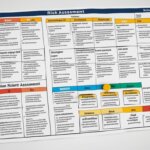Table of Contents
A gap analysis is a valuable tool that helps businesses identify and bridge strategic gaps for enhanced performance and resource optimization. It involves a thorough needs assessment, allowing companies to understand their current situation and determine what steps are necessary to achieve their ideal state.
By examining the gap between current performance and potential or ideal performance, businesses gain insights into areas of improvement. This analysis enables organizations to streamline processes, optimize resources, and identify market gaps for better strategic decision-making.
Whether it’s launching a new product, improving productivity, managing the supply chain, or analyzing sales performance, gap analysis provides a comprehensive framework to assess and close gaps within a business.
In this article, we will explore what gap analysis is, its benefits, common types of gap analysis, steps to conduct an analysis, and some useful tools to facilitate the process.
What is a Gap Analysis?
A gap analysis is the process of assessing the current state of a business and comparing it to the desired or ideal state. It involves analyzing the performance, identifying the gaps between the current and ideal situation, and determining the steps required to bridge those gaps. The gap analysis helps businesses understand why they are not performing at their peak potential and how to fix it. It can be used to improve processes, products, services, and overall business performance.
Identifying the Gap
When conducting a gap analysis, the first step is to assess the current situation of the business. This includes evaluating the performance metrics, such as sales figures, customer satisfaction, and operational efficiency. By understanding the strengths and weaknesses of the business, it becomes easier to identify the gaps between the current and ideal situation.
Bridging the Gap
After identifying the gaps, the next step is to develop a plan to bridge them. This involves determining the necessary actions and resources required to move from the current state to the desired state. It may involve implementing new strategies, improving processes, or acquiring additional resources. The ultimate goal is to close the gaps and achieve the desired level of performance.
The Importance of Needs Assessment
A needs assessment is a critical component of the gap analysis process. It involves evaluating the requirements and expectations of stakeholders, including customers, employees, and shareholders. By understanding their needs, businesses can align their goals and strategies accordingly. This ensures that the actions taken to bridge the gaps are focused on addressing the most pressing needs and priorities.
| Current Situation | Ideal Situation | Gaps |
|---|---|---|
| The business has a high employee turnover rate, leading to lost productivity and increased costs. | The business has a stable and motivated workforce, resulting in improved productivity and reduced costs. | The gap lies in employee retention and engagement. |
| The business has outdated technology systems, causing delays and inefficiencies. | The business has state-of-the-art technology systems, enhancing operational efficiency and customer satisfaction. | The gap exists in technology infrastructure and implementation. |
| The business lacks a robust marketing strategy, resulting in low brand awareness and limited market reach. | The business has a comprehensive marketing strategy, increasing brand awareness and expanding market presence. | The gap is evident in marketing planning and execution. |
Benefits of Gap Analysis
Gap analysis provides numerous benefits for businesses, offering valuable insights that can lead to significant improvements. By conducting a thorough assessment of the current state and comparing it to the desired state, gap analysis enables organizations to bridge strategic gaps and enhance their performance.
“Gap analysis helps businesses optimize resources, improve processes, and identify market potential.”
One of the key benefits of gap analysis is its ability to facilitate external benchmarking. By comparing their performance to industry standards or competitors, businesses can gain a comprehensive understanding of their position. This benchmarking process aids in identifying areas of improvement, setting realistic targets, and measuring progress over time.
Another advantage of gap analysis is its role in profit percentage analysis. By analyzing the reasons behind not achieving target profits, businesses can pinpoint areas for improvement, reduce inefficiencies, and optimize resource allocation. This process not only enhances profitability but also streamlines operations and increases overall efficiency.
Moreover, gap analysis is a valuable tool for process improvement. By identifying gaps and weaknesses in current processes, organizations can develop targeted strategies to enhance productivity and streamline workflows. The analysis helps businesses understand which processes are effective and which ones need improvement, leading to more efficient operations and resource utilization.
“Gap analysis helps businesses understand key performance indicators, sales targets, and uncovers market potential.”
Furthermore, conducting a gap analysis allows businesses to gain a deeper understanding of key performance indicators (KPIs) and sales targets. By assessing the current state and identifying the gaps, organizations can develop targeted strategies to achieve their goals and improve overall performance.
Additionally, gap analysis can uncover market potential by identifying gaps in the market. By analyzing the current landscape and understanding customer needs and preferences, businesses can develop innovative products and services, and expand their market share.
“By conducting a gap analysis, businesses can optimize resources and improve overall performance and profitability.”
In summary, gap analysis delivers a range of benefits for businesses, including enhanced external benchmarking, profit percentage analysis, improved process efficiency, better understanding of KPIs and sales targets, and insights into market potential. By leveraging the power of gap analysis, organizations can optimize resources, drive process improvement, and unlock their full market potential.
Common Types of Gap Analysis
In gap analysis, different types of analysis can be conducted based on the specific area being analyzed. These different types enable businesses to focus their efforts on addressing specific gaps and improving their overall performance. The common types of gap analysis include:
1. Performance Gap Analysis
Performance gap analysis focuses on evaluating the variance between actual performance and the expected or desired performance. It encompasses various aspects such as mission, values, and strategic objectives. By identifying and understanding the gaps in performance, businesses can develop strategies to bridge them and enhance their overall effectiveness.
2. Product Gap Analysis
Product gap analysis involves comparing actual sales with the budgeted or projected sales. This analysis helps businesses identify areas where their products are underperforming in terms of meeting sales targets. By identifying the gaps and understanding the reasons behind them, businesses can make informed decisions to improve their product offerings and drive better sales performance.
3. Profit Gap Analysis
Profit gap analysis focuses on understanding the reasons behind not achieving target profits. By analyzing revenue streams, costs, and other financial factors, businesses can identify gaps in their profit margins. This analysis helps to uncover areas where profitability can be optimized and informs strategies for improving financial performance.
4. Manpower or HR Gap Analysis
Manpower or HR gap analysis assesses the skills, competencies, and performance of the workforce. By conducting this analysis, businesses can identify gaps in their workforce capabilities, understand staffing requirements, and make informed decisions regarding training, recruitment, and resource allocation. Manpower gap analysis is crucial for optimizing human resources and ensuring that the right people with the right skills are in place to drive business success.
By conducting these various types of gap analysis, businesses can gain valuable insights to inform decision-making, drive improvement, and bridge gaps in performance, products, profits, and manpower.
| Type of Gap Analysis | Focus Areas |
|---|---|
| Performance Gap Analysis | Performance variance, mission, values, strategic objectives |
| Product Gap Analysis | Sales performance, product offerings |
| Profit Gap Analysis | Financial performance, profit margins |
| Manpower or HR Gap Analysis | Workforce skills, competencies, staffing requirements |
How to Conduct a Gap Analysis
Conducting a gap analysis involves several steps that allow businesses to bridge the gap between their current state and desired future state. By following these steps, companies can identify target objectives, assess their current situation, and chart a path towards achieving their goals.
- Establish target objectives: Begin by clearly defining the target objectives based on the company’s mission and strategic goals. This step sets the direction and purpose of the gap analysis.
- Analyze the current state: Gather relevant data on performance and resource allocation to evaluate the current state of the business. This analysis provides insights into the strengths, weaknesses, and areas for improvement.
- Identify the future state: Determine the desired outcome or future state that the business aims to achieve. This step helps define the ideal state and sets the benchmark for success.
- Describe the gaps: Identify and describe the gaps between the current and future states. This analysis highlights the areas that need improvement and helps prioritize actions.
- Propose possible solutions: Brainstorm and propose potential solutions to bridge the identified gaps. This step involves considering different strategies, resources, and tactics that can help the business move towards the future state.
- Create a comprehensive plan: Develop a detailed plan with clear objectives, timelines, and milestones to bridge the identified gaps. This plan acts as a roadmap for the business, guiding the implementation of necessary actions.
By following these steps, businesses can conduct a thorough gap analysis, align their operations with target objectives, and take the necessary steps to bridge the gaps between their current state and desired future state.
Example:
Let’s consider a retail company that wants to increase its online sales by 30% within the next year. To conduct a gap analysis, the company would:
- Establish the target objective of increasing online sales by 30%.
- Analyze the current state by collecting data on current online sales performance, website traffic, and customer conversion rates.
- Identify the future state by setting a target for online sales based on market research and industry benchmarks.
- Describe the gaps between the current and future states, such as identifying areas where the website needs improvement or potential marketing strategies to attract more customers.
- Propose possible solutions, such as website redesign, targeted marketing campaigns, or improved customer engagement strategies.
- Create a comprehensive plan with specific actions, timelines, and responsibilities to implement the proposed solutions and bridge the identified gaps.
By conducting a gap analysis and following through with the plan, the retail company can optimize its online sales strategies and work towards achieving its target objectives.
Gap Analysis Tools and Examples
When conducting a gap analysis, businesses can utilize various tools to gain deeper insights into their performance and identify areas for improvement. Two widely recognized tools for conducting a comprehensive gap analysis are the SWOT analysis and the McKinsey 7-S Framework.
The SWOT analysis (Strengths, Weaknesses, Opportunities, and Threats) enables businesses to assess their internal strengths and weaknesses, as well as external opportunities and threats in the market. By analyzing these factors, businesses can uncover gaps in their current strategies and determine how to leverage their strengths and opportunities while mitigating weaknesses and threats.
The McKinsey 7-S Framework is another effective tool that focuses on seven critical elements of a business: strategy, structure, systems, style, staff, skills, and shared values. By assessing each component, businesses can identify gaps and inconsistencies within their organizational structure and work towards aligning all elements to achieve enhanced performance and operational efficiency.
An additional tool that businesses can use for gap analysis is the Nadler-Tushman model. This model examines the interrelations between different parts of a business to identify operational gaps and optimize performance. By understanding how various components interact, businesses can determine where improvements are needed and implement changes accordingly.
These gap analysis tools provide a structured approach to assessing and improving business performance. While the SWOT analysis focuses on internal and external factors, the McKinsey 7-S Framework and the Nadler-Tushman model delve into specific aspects of the organizational structure. By leveraging these tools, businesses can gain valuable insights and make informed decisions to bridge the gaps and drive success.
FAQ
What is gap analysis?
Gap analysis is a tool used by businesses to understand their current situation and identify what needs to be done to achieve their ideal state. It involves examining three key elements: the current performance, the potential or ideal performance, and the steps required to bridge the gap between the two.
How can gap analysis bridge business gaps?
Gap analysis helps bridge business gaps by identifying areas for improvement and determining the steps required to optimize resources and enhance performance. It helps businesses understand why they are not performing at their peak potential and how to fix it.
What are the benefits of gap analysis?
Gap analysis offers several benefits to businesses. It helps in external benchmarking and profit percentage analysis. It improves processes and productivity by identifying areas for improvement. It helps in understanding key performance indicators and sales targets and can uncover gaps in the market.
What are the common types of gap analysis?
Gap analysis can be categorized into different types based on the specific area being analyzed. Performance gap analysis focuses on the variance between actual and expected performance. Product gap analysis compares actual sales with budgeted sales. Profit gap analysis helps understand the reasons behind not achieving target profits. Manpower or HR gap analysis assesses the skills and performance of the workforce.
How do you conduct a gap analysis?
Conducting a gap analysis involves several steps. The first step is to establish target objectives based on the company’s mission and strategic goals. The next step is to analyze the current state by collecting relevant data on performance and resource allocation. The future state is identified by determining the desired outcome. The gaps between the current and future states are described, and possible solutions are proposed. A comprehensive plan with clear objectives and a timeline is created to bridge the identified gaps.
What tools can be used for gap analysis?
Several tools can be used to conduct a gap analysis. The SWOT analysis helps identify strengths, weaknesses, opportunities, and threats. The McKinsey 7-S Framework focuses on seven key components of a business to identify gaps and improve performance. The Nadler-Tushman model examines how different parts of a business work together and identifies operational gaps. These tools provide a structured approach to conducting a gap analysis and can be adapted to specific business needs.












